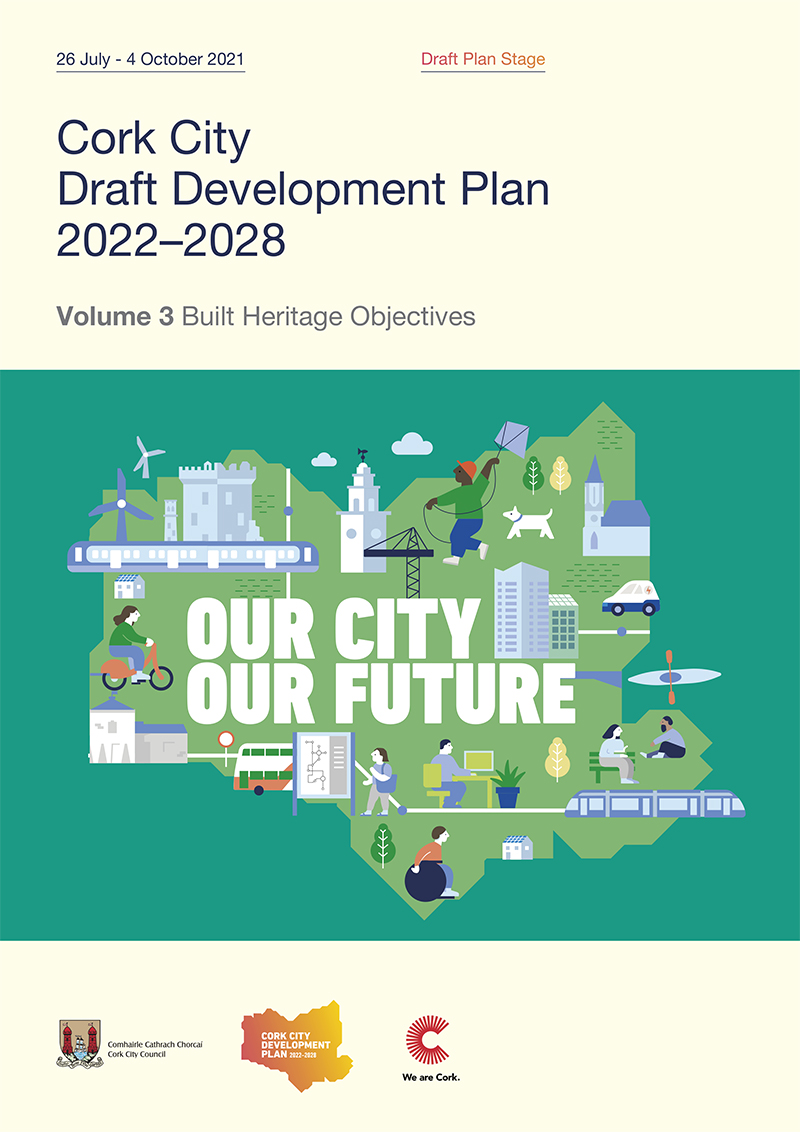Volume 3 - Built Heritage Objectives
Introduction
What is Built Heritage and how it is protected?
1.1
Cork City is home to a great wealth of built heritage, including historic buildings, structures, monuments, archaeology and conservation areas. Built heritage has evolved over centuries and is a response to landscape, resources, influences and activities. It helps create a sense of a place and makes our neighbourhoods distinctive. The built heritage of Cork city is a finite and precious resource, as the buildings, streets and quays combine to give the City its unique expression. We all have a responsibility to protect, conserve and sensitively use our historic buildings. Cork City Council will work with relevant stakeholders to sensitively upgrade and adapt historic buildings for modern day uses and protect buildings against the impacts of climate change. Built heritage in Cork City is protected in two ways:
(1) The Record of Protected Structures and
(2) Architectural Conservation Areas. Protected Structure
What is a Protected Structure?
1.2
A Protected Structure is a building which is identified by Cork City Council as having special architectural, historical, archaeological, artistic, cultural, scientific, social or technical interest and is included on the Cork City Council Record of Protected Structures, which forms part of the Development Plan. Cork City Council’s Record of Protected Structures currently includes approximately 1,200 buildings. When a building is designated a Protected Structure, it is protected under Part IV of the Planning and Development Act, 2000 as amended. This means that owners and occupiers have a responsibility to ensure that the structure or any element of a protected structure is not endangered. Some works to protected structures that may normally otherwise be exempted development may require planning permission – including, for example, the replacement of original windows or doors. However, there is considerable scope to alter to modify a Protected Structure (for example, the installation of new services, new bathroom or kitchen fittings, etc.) without affecting its special character.
1.3
The Conservation Section of Cork City Council is always available to provide guidance and answer any queries. Cork City Council may make additions or deletions from its Record of Protected Structures at any other time by following prescribed procedures. The making of an addition to or deletion from the Record of Protected Structures is a reserved function for the Elected Members of the Council.
What is an Architectural Conservation Area?
1.4
The designation of an area as an Architectural Conservation Area (ACA) under the Planning Acts is a way to protect the character of Cork’s historic areas. The aim is to protect their special characteristics and distinctive features while encouraging suitable contemporary development. Some works to buildings in an Architectural Conservation Area, regardless of whether it is a Protected Structures, that may normally otherwise be exempted development may require planning permission: this can mean replacing the windows or doors, changing historic paving or replacing ironwork railings may require planning permission.
1.5
The Conservation Section of Cork City Council is always available to provide guidance and answer any queries in this regard. The list of Architectural Conservation Areas and description of each are is included below in this Volume and forms part of the Development Plan.
Built Heritage Objectives in the Development Plan
1.6
This Volume forms part of the overall Draft Cork City Development Plan 2022-2028 and reflects the statutory requirements in relation to our built heritage.
1. Architectural Conservation Areas, displayed in 3 categories:
– existing Architectural Conservation Areas that are proposed to remain unchanged,
– existing Architectural Conservation Areas that are proposed to be modified, and
– proposed new Architectural Conservation Areas.
2. Record of Protected Structures (available online here www.corkcity.ie)
3. Record of Monuments and Places (available online here www.archaeology.ie)
4. Views and Prospects
1.7
This Volume of the Draft Development Plan should be read alongside Volume 1 – Written Statement and Volume 2 – Mapped Objectives. Chapter 8 in Volume 1 – Written Statement addresses heritage, arts and culture and includes development objectives in relation to built heritage. The Views and Prospects are mapped in Volume 2 – Mapped Objectives.
